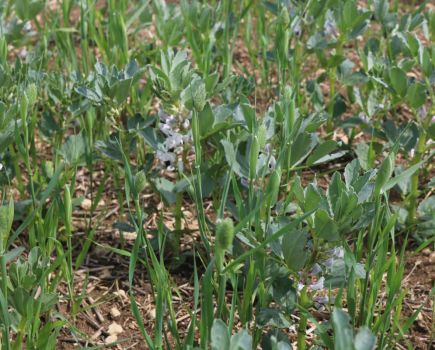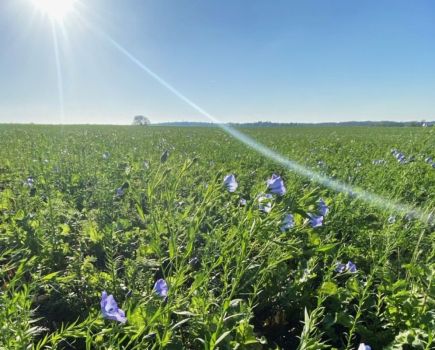What’s the true value of organic matter? A Rothamsted researcher explained how it builds resilience in soils during the recent Hutchinsons Agroecology conference.
“Connectivity in soils is what drives soil health.”
By Mike Abram
What is the true value of building organic matter in soils? For Rothamsted Research soil microbiologist Professor Andy Neal, it isn’t increased yield or to gain access to carbon markets.
Indeed, albeit perhaps surprisingly, Andy highlights that research suggests organic matter additions to soils don’t increase yields in autumn-sown crops, although there’s some evidence that it has a positive impact in potatoes and spring-sown cereals.
Evidence is also lacking that increasing soil organic matter will provide value through revenues from carbon markets, he says. “Yes, there’s potential to sequester carbon, but it’s not sufficient to make a dent in the real climate issues we have.”
Instead, the real value lies in the microbial interactions with organic matter and the impact on soil structure, he says, and the increased resilience that it can ultimately bring to soils.
Most soil organic matter originates from plant tissue, which goes through a complex cascade of degradation, first by shredders such as earthworms, then fungi and bacteria and other microbes.
“The important part for organic matter sequestration in the soil is getting small enough molecules to be absorbed onto mineral surfaces and so no further microbial activity can take place,” explains Andy. “Once it’s locked away, it creates this wonderful structure that’s vitally important to the way microbes work.”
Andy studies at a scale smaller than the average diameter of a human hair, which allows him to focus on pore structure. “That’s where the water holding capacity of soil occurs, because with pores that size, capillary action holds water in soil once it drains. But it’s also where we see greatest enzyme activity, fine roots and organic matter being deposited directly from roots into soil, and mycorrhizae fungi,” he says.
Detailed analysis has found that soils with less than 1% organic matter have very little porosity or connectivity between pores. “My suggestion is that connectivity in soils is what drives soil health. The more connected the pore spaces, the healthier your soil will be as you increase organic matter.”
Just a 1% increase in soil organic carbon gives around a 354,000 l/ha increase in water storage capacity in the top 30cm of soil, he estimates. “There’s a real advantage to increasing pore space in soil, and the way you do that is to pump more organic matter through the soil, which the microbes use, break it down to a form that can stick to mineral surfaces and build this fabulous architecture.”
That holds true for clay soils, but less so for sandy soils, he notes. “In extremely sandy soils, research suggests that organic matter has virtually no influence on the soil structure because a sandy soil is made up of larger particles, all similar in size and shape, and you end up with huge voids in between those particles that can’t form any architectural structure.”
One benefit from improved structure is that it allows the plant growth hormone ethylene to diffuse away from root tips, explains Andy. “If ethylene increases to a high enough concentration, it stops root growth. If you have a well-structured soil, you don’t get that and roots continue to grow so not only are you storing more water, you’re also allowing roots to explore more of it because there’s no barrier to their growth.”
But how you manage soils doesn’t change the soil’s intrinsic carbon to nitrogen ratio, according to evidence from Rothamsted’s Broadbalk long-term experiment, says Andy.
“All that changes is the more nitrogen you have in the soil, the more carbon you can sequester, so don’t worry about changing it as it’s under the influence of microbial metabolism and mineral content.”
Using CT scanning, Rothamsted was able to show the soil structure in the plots receiving high 35t/ha/year FYM inputs in the experiment was virtually identical to nearby long-term woodland and unmanaged pastures.
“So if you have enough carbon to hand, which is the challenge, you can still plough every year and have the equivalent soil structure at these small scales to pasture or woodland.”
The research also revealed that inorganically fertilised soils had only a half to two-thirds of the soil pore space, even at field capacity, compared with the plots receiving FYM. “In the FYM plots, because of the increased structure there was an awful lot more oxygen availability.”
That matters for nitrogen use efficiency, he explains, because when microbes run out of oxygen, they have evolved to use either nitrate or sulphate to respire. “When they do this, they grow much more slowly, but for the farmer they’re using nitrogen in ways you didn’t expect, wasting money, and producing a lot of nitrous oxide.”
When Rothamsted compared soils receiving FYM and inorganic fertiliser at equivalent rates, the FYM soils were releasing less than half the nitrous oxide, says Andy.
“So I think the greatest challenge you have as farmers looking for healthy soils is getting as much access to oxygen in your soils as possible. Fortunately, you can do that if you have sufficient organic matter or if you build it up.”
All of those benefits – the better soil structure, greater access to water, oxygen and improved nutrient use efficiency – ultimately provide resilience, he suggests.
“You don’t see that resilience every year, but when things get tough, you’ll appreciate that resilience – and organic matter gets you there.”
This article was taken from the latest issue of CPM. Read the article in full here.
For more articles like this, subscribe here.
Sign up for Crop Production Magazine’s FREE e-newsletter here.




